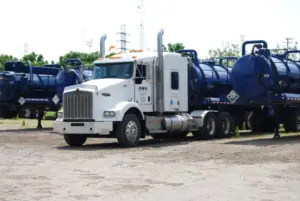Differentiating Hazardous Waste from Non-Hazardous Waste
Regardless of industry, companies inevitably must deal with waste. Proper storage, transportation and disposal of waste streams is determined by the toxicity. However, often there is a fine line between what is considered hazardous and what is not.
Improper management of waste streams can negatively impact a company’s bottom line, its reputation, and the communities in which it operates. Therefore, waste management should never be an afterthought. To ensure all waste streams are managed safely and within regulatory requirements, it is important to understand the nuances of hazardous and non-hazardous waste across a waste stream’s life cycle, which includes collection, storage, transportation, and final disposition.
Defining Hazardous Waste
Hazardous waste is any waste where direct exposure presents a threat to a people or the environment. This type of waste must be professionally disposed of, due to the dangers it poses.
The EPA classifies hazardous waste across four official lists:
F List
These hazardous wastes involve chemicals and waste streams that stem from industrial and manufacturing processes. They include waste like chemicals used in cleaning or degreasing equipment that isn’t specific to a certain industry.
K List
K listed waste are hazardous materials that stem from industry-specific practices. This can include waste formed from practices like pesticide manufacturing, wood preservation, inorganic chemicals manufacturing, and petroleum refining.
Common hazardous wastes on the K list include:
● Wastewater treatment sludge
● Byproduct salts
● Bottom-sediment sludge
● Distillation residues
If you have any doubts on whether your industry produces hazardous waste, an environmental services team can help you determine the toxicity of the waste coming from your business practices
P/U List
The hazardous wastes on the P and U lists are both dangerous to humans, even in cases where minor exposure is involved. There are several different types of hazardous waste chemicals on these lists.
Common examples of P and U list waste include the following:
● Arsenic acid
● Fluorine
● Nitric oxide
● Nitrogen oxide
● Strychnine
● Benzene
● Ethyl ether
● Mercury, and more!
If the waste contains one of the chemicals listed on the P and U lists, is unused, and is in the form of a commercial chemical product, then it is considered to be a high risk and must be handled professionally and with care.
Non-Hazardous Waste
Non-hazardous waste is typically insoluble in water and is accepted at landfills.
Common examples of non-hazardous waste include the following:
● Empty aerosol cans
● Non-surgical medical waste
● Non-radioactive medical waste
● Food waste
● Standard batteries
● Construction debris
● Used tires
Although some of these waste materials can still be hazardous to the environment if left to rot out in the open, a landfill or waste disposal professional can help ensure that these products are contained and effectively disposed of.
Managing Hazardous Waste
Moving or disposing hazardous waste is dangerous for any inexperienced team. Not only does exposure to hazardous waste put personnel at risk, but even the slightest mismanagement can result in a dangerous spill that puts your immediate work environment as well as the community around your site at risk.
Companies needing to dispose of large volumes of waste, regardless of the waste’s profile, should enlist the services of respected environmental waste service provider, such as TAS Environmental. Doing so ensures safety and compliance. To further mitigate risk and minimize liabilities, TAS provides comprehensive waste services, including:
● Efficient planning
● Necessary equipment for chemical containment
● 24/7 emergency waste response, and more.
TAS Environmental Services is always available to help companies reduce the risk of a hazardous spill, minimize environmental exposure to unsafe products, and save money through efficient and experienced waste management practices.
Contact TAS to learn more about proper waste management, industrial services, and emergency response.





